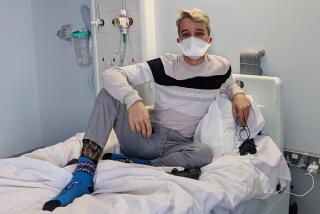Self-Experimenting for Science’s Sake
- Share via
Last week, among other things, we reported that our fingernails grow at the rate of about 3 mm a month. How, we wondered, did people ever arrive at that number?
Dr. Philip Fleckman, a nail expert at the University of Washington in Seattle, told us that through the decades, various scientists have sought estimates by studying groups of people--hundreds of Japanese adults and kids in one study; 49 British Navy men in another. (The second study revealed that seamen’s nails grew slower when they sailed in the frigid Arctic seas.)
And then there was Dr. William Bean, who measured his own left thumbnail for decades and published the results in scholarly articles with titles like “Nail Growth: A Twenty Year Study.”
Don’t let the title put you off! It makes for strangely compelling reading.
Bean went to considerable lengths to track what his nails were up to--tattooing a little dot at the flesh at the base of the nail, then filing a groove at the nail base once a month as new nail emerged. Once a week, he stuck his thumb into a little wooden frame that held it snugly, then took a photograph. This was a man with a mission.
Bean’s papers are filled with charts of nail growth and observations: the “unaccountable spurts and lags”; the sudden screech-to-a-halt in growth during his sickness from mumps in 1950; a slower growth rate during two bouts of flu; and, over the years, an inexorable, ominous trend. At age 32, he wrote, his nail grew 0.123 mm a day. By 42, that number was 0.111 mm. By 52, it was 0.105 mm.
In fact, his 20-year paper (published in 1963) ends on a dark note: “A sharp decline began at the age of 49, and seems to be continuing,” he wrote--enough to make one wonder if we’re ever going to hear again from him.
But in 1974 (thank heavens) he’s back again with “Nail Growth: 30 Years of Observation,” in which he reports that his nail growth continued to slow--and slow and slow. Of all the reminders of mortality--graying hair, failing eyesight, a less sprightly spring to one’s step--the nail, he concluded, reigned supreme.
Bean was by no means the only scientist to experiment on himself: We learned more from Jon Franklin, a professor at the University of Maryland and co-author of a (now out of print) book called “Guinea Pig Doctors.” (The name was later changed to “If I Die in the Service of Science” so that clerks would stop filing it next to books called things like “The Care and Feeding of the Goldfish.”)
There was Werner Forssmann, a German doctor who believed that it should be possible to thread a catheter all the way into the interior of the heart--but was expressly forbidden by his chief of surgery to try such a risky thing.
Forssmann went ahead anyway one sleepy afternoon when the staff was eating its lunch--opening his own arm vein, inserting the catheter, threading it to the heart, then taking an X-ray to prove he’d done it. He later won a Nobel Prize.
There was Dr. John Paul Stapp, who studied the biological effects of sudden deceleration firsthand--by riding on rocket sleds across the California desert sand at speeds of up to 632 mph, then smashing into equivalents of brick walls. He almost tore the retinas off his eyes on one occasion--which sounds like he got off lightly.
And there was Dr. John Hunter, an 18th century physician who studied venereal disease by (among other things) deliberately infecting himself with a sample of pus from a patient, then carefully charted the course of the disease. (Yikes!)
Of course, such self-experimentations don’t always further the course of science. In the 19th century, the German doctor Max von Pettenkofer drank live cholera bacteria obtained from a dying patient in order to show that the bugs couldn’t single-handedly cause the disease. (Before drinking, he apparently proclaimed that were he to die: “I shall die in the service of science as a soldier perishes on the field of honor.”)
Pettenkofer got the runs--but didn’t apparently come down with cholera. There’s luck for you.
*
If you have an idea for a Booster Shots topic, write or e-mail Rosie Mestel at the Los Angeles Times, 202 W. 1st. St., Los Angeles, CA 90012, rosie.mestel@latimes.com.




